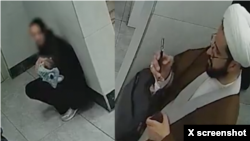On March 3, Iran International, a London-based Persian-language news television channel, shared CCTV footage taken inside a hospital in the Iranian city of Qom, causing heated discussions both inside Iran and online.
The video shows a brief conflict between a young woman and a man dressed in a robe traditionally worn by Islamic clergymen in Iran.
While the CCTV footage does not show what caused the conflict, Iranian media news reports, as well as captions added to the same video clip posted on X and YouTube, indicate that the woman was cradling her sick child when her hijab slipped down her shoulders and the cleric started recording her on his mobile phone. The woman protested being recorded and asked that the footage to be deleted, which the man refused to do.
In a March 10 piece headlined “Who is the main culprit in the story of Qom clinic?” the “Political group” of the Fars News Agency, controlled by Iran’s Islamic Revolutionary Guard Corps (IRGC), “examined” the incident.
The piece praised the cleric’s behavior, identifying him as “Ferd Rouhani” and describing him as a “young activist who seems to have the intention of forbidding evil.” Fars concluded that his actions were appropriate and in accordance with the law.
The woman, on the other hand, violated multiple laws, the article stated, including by not wearing a mandatory hijab and by verbally attacking a religious man. The piece said the woman in the video was another example of a trend in which “prostitution has become more public day by day.”
It concluded:
“It is clear that, first of all, the woman who is exposed has committed the forbidden act of uncovering the hijab. Of course, she commits another mistake by shouting and attacking the young cleric.”
That is misleading.
It is true that the actions of the cleric did not violate Iran’s law, and the woman’s loss of the hijab covering her head and voicing anger at a religious man in public are considered grave crimes under Iranian law.
However, the young woman apparently acted out of extreme distress and fear, which is not unfounded, given that the Iranian authorities can use the cleric’s recording of her as incriminating evidence in court.
Iran's Islamic clergy is infamous for brutal punishment of women who disobey the country’s mandatory hijab laws. Violators face prison terms and large financial fines. They are also often victims of physical attacks, some ending up with their faces splashed with flesh-eating acid, while others, like Mahsa Amini, end up dead.
Fars said the actions of the person who sent the CCTV footage to “the international terrorist network” (Iran International is critical of the Iranian regime) “should not be ignored.” The only reason the video gained public attention and resonance is because it was used in a “game of the enemy,” “to create a gap between the people” and lead to “the division of Iran,” the news agency said.
After Fars posted the piece, several social media users claimed that the Iranian authorities have identified and arrested the woman in the video. Others said the whistleblower who leaked the CCTV footage was also identified and arrested. Some even claimed that the hospital where the incident took place was shut down.
Polygraph.info was unable to independently verify those claims. Iran International reported, though, that Qom’s prosecutor Hassan Gharib announced on March 10 that he had issued an order to identify and prosecute the individual who leaked the CCTV footage to Iran International. No arrests have been made in connection with the incident, Gharib said.
Fars likewise reported that no one has been arrested in connection with the incident and that “the investigation is ongoing," adding: “Rumors about the closure of the clinic or the cancellation of its license are not true, and no restrictive measures have been taken.”
Polygraph.info’s Persian-speaking reporter reviewed the CCTV footage at the center of the controversy.
The video clip appears to have been filmed inside a crowded corridor, reportedly in a hospital. It starts with a young woman dressed in black but wearing no headscarf running in front of the cleric, who seems to be on his way out of the building. She asks the cleric to delete the recordings he made of her from his mobile phone without her consent.
Other women join in support of the woman without a hijab, and they all shout at the cleric, demanding that he delete the footage or hand over his phone. The situation escalates, with the cleric refusing to delete the footage and attempting to leave.
The young woman, seemingly terrified, becomes increasingly agitated and ends up having what looks like a panic attack. Her supporters keep pressuring the cleric until he runs away while the crowd tears off his cloak and his turban.
On March 11, a video was posted on social media platform X of a similar incident in Iran, in which a religious individual was seen confronting a woman and arguing over her hijab in the metro.





